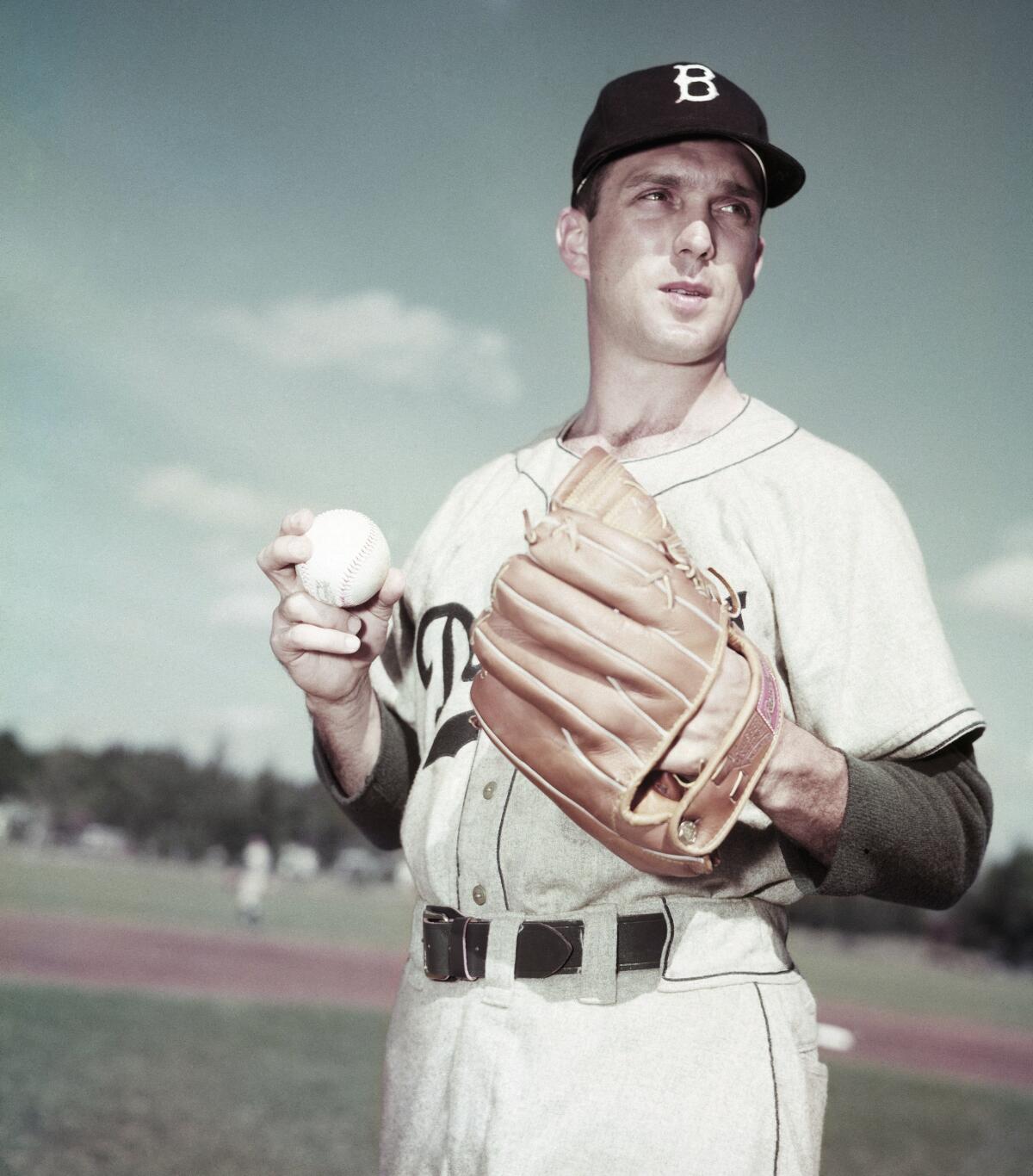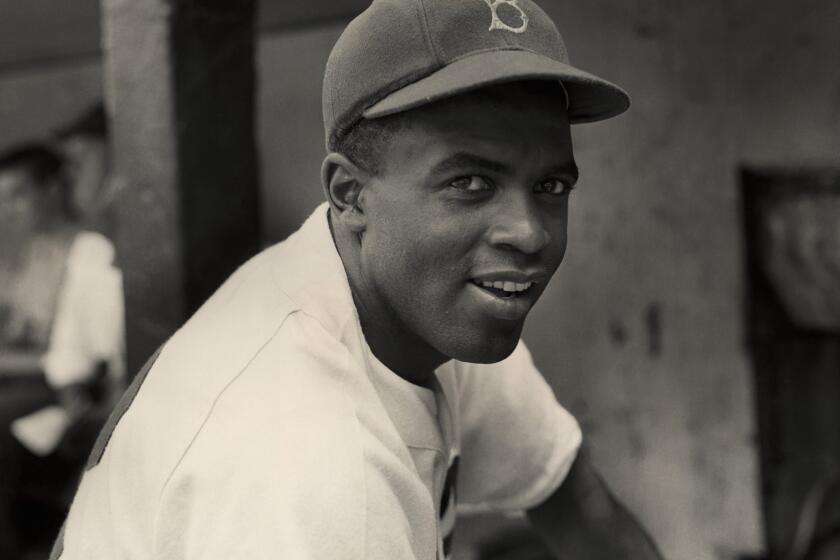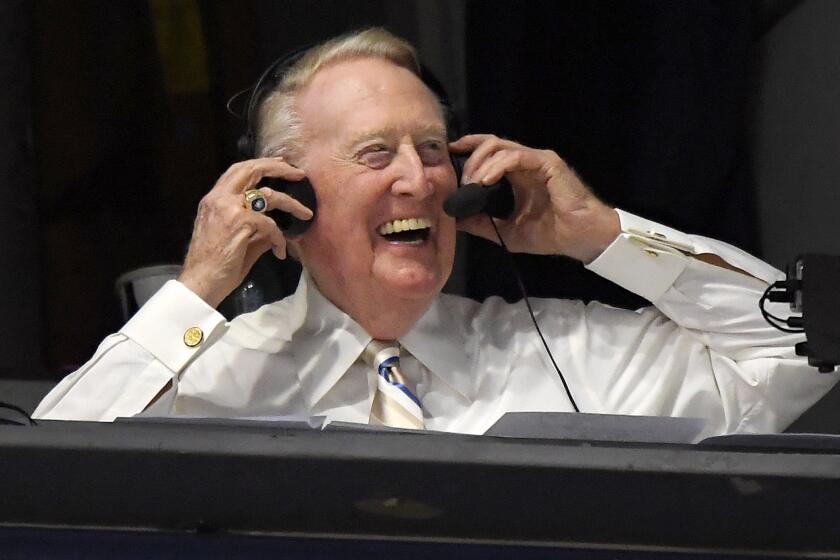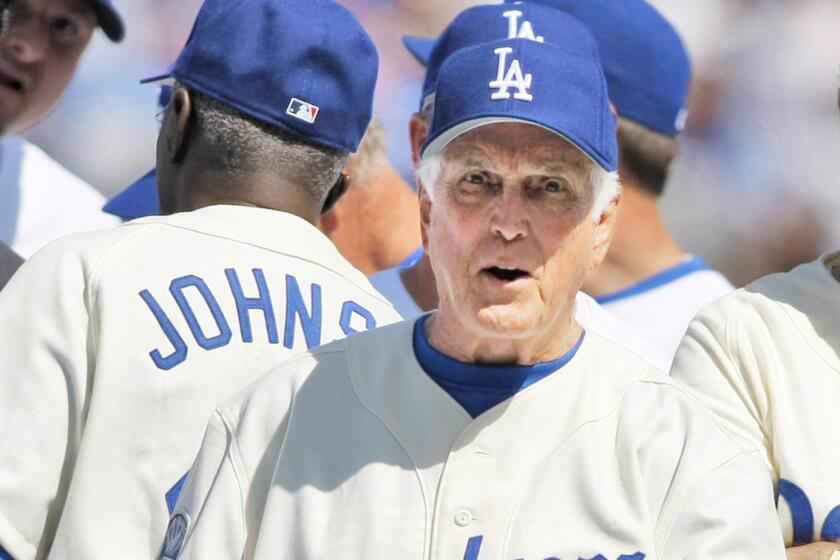Carl Erskine, Dodgers pitcher and advocate for those with special needs, dies at 97

- Share via
Carl Erskine, one of the last living Brooklyn Dodgers and a mainstay of a pitching rotation that carried the team to four World Series in the 1950s before the team headed to Los Angeles, has died in his hometown of Anderson, Ind.
A thoughtful man who threw himself into charity work later in life, Erskine died early Tuesday morning after a brief illness. He was 97.
Part of a nearly mythical group of ballplayers who were anointed “The Boys of Summer” by author Roger Kahn, Erskine played alongside Pee Wee Reese, Duke Snider, Roy Campanella and Jackie Robinson, who became his closest friend on the team. Later in life, Erskine credited Robinson for teaching him some of life’s most important lessons — tolerance, patience, care and understanding.
Erskine said he was stunned at the racial taunts directed at Robinson after he became the first Black player in Major League Baseball. He said Robinson received death threats, was typically barred from staying with his white teammates in hotels while on the road and had teammates who refused to play with him. In Atlanta, he said, Black fans couldn’t buy tickets and were forced to watch Robinson play from a levee behind the right-field fence.
Years later, he said, he visited Atlanta and noticed a statue of Henry Aaron where the Black fans once gathered. “That’s a major step forward,” he told Times columnist Patt Morrison in 2013.
In 1972, 25 years after he broke MLB’s color barrier, Robinson reflected on the ongoing fight for equality. Former Times sportswriter Ron Rapoport recounts that interview just months before Robinson’s death.
On the field, Erskine was known for his strong overhand curveball and his dependability as a starting pitcher in 12 seasons with the Dodgers, in Brooklyn and Los Angeles. By the time he retired early in the 1959 season, he had compiled a record of 122 wins and 78 losses and had an earned-run average of 4.00. He threw two no-hitters: against the Chicago Cubs in 1952, which included an hourlong rain delay, missing a perfect game after walking a relief pitcher; and in 1956 against the team’s dreaded rivals, the New York Giants.
The latter was particularly sweet, Erskine said, because on the day of the game, Giants scout Tom Sheehan was quoted in a New York newspaper as saying that the Dodgers were no longer a powerhouse because Robinson and Campanella were too old and that Erskine “couldn’t win with the garbage he was throwing.”
“After the last out, Jackie rushed over to the Giants dugout where the scout was sitting and pulled the article out of his back pocket and waved it at him and yelled, ‘How do you like that garbage?’” Erskine said in a 2012 interview. “That’s how fierce our rivalry was with the Giants in New York.”
The highlight of Erskine’s career probably came in Game 3 of the 1953 World Series against the Dodgers’ other crosstown nemesis, the New York Yankees. After being shelled and removed early in Game 1, Erskine returned as the Game 3 starter and struck out a then-World Series record 14 batters — including future Hall of Famer Mickey Mantle four times — in a 3-2 victory at Ebbets Field in Brooklyn.
“I didn’t know about the record until I got into the clubhouse and the writers came in and told me,” Erskine said. “They announced it over the PA system, but I was so oblivious to everything but what I was doing on the mound that I didn’t even hear it.”
The Dodgers eventually lost the series, four games to two. His World Series strikeout record stood until 1963, when fellow Dodger Sandy Koufax struck out 15 Yankees in Game 1 en route to a Dodgers sweep.
Listed at 5 feet 10 and 165 pounds, Erskine made his big-league debut on July 25, 1948, against the Pirates at Forbes Field in Pittsburgh. He entered the game as a reliever in the bottom of the seventh with the Dodgers trailing 5-3 and pitched a scoreless inning, walking two batters before inducing future Hall of Famer Ralph Kiner, the National League’s home run leader at the time, to line into an inning-ending double play.
Erskine was lifted for a pinch-hitter and the Dodgers scored three runs in the top of the eighth and went on to win, giving him his first victory.
In Brooklyn, they still tell the story of a Dodgers fan who takes his son on a pilgrimage to the site of Ebbets Field.
In his third major league game 11 days later against the Cubs, Erskine pulled a muscle in his right shoulder, an injury from which he never fully recovered. He wound up pitching the rest of his career in pain.
“I never wanted to be known as a sore-arm pitcher, so I didn’t say much about it,” Erskine said. “I got treatment on the side, by myself, as best I could. I took a lot of cortisone shots. But I never opted out of a start in my entire career.”
By the time he retired, he had a winning record in 11 of his 12 major league seasons.
Erskine’s best season came in 1953, when he won 20 games while losing only six, including pitching a now-unheard-of 16 complete games while compiling a 3.54 ERA. Thanks in no small part to Erskine, the Dodgers won the National League pennant that year before losing another heartbreaker World Series to the Yankees, after leading the series three games to two.
In the 1955 World Series, in which the Dodgers finally beat the Yankees after five previous tries, Erskine started Game 4. He gave up three runs in three innings and was lifted for a pinch-hitter. The Dodgers went on to win the game 8-5.
When the Dodgers won the Series three days later, Erskine remembers the contrasting emotions of a team that had waited so long for that moment. When the final out was recorded, the Dodgers mobbed starter Johnny Podres in a rowdy celebration on the mound.
“But on the way up the ramp to our clubhouse, after realizing that we had finally beat the Yankees in the World Series, we were more reverential than boisterous,” Erskine said. “Before the writers came in, there was no noise in the clubhouse and there were tears in the eyes of more than one player.”
By the end of the 1957 season, Erskine was considering retirement as the team was preparing to move to Los Angeles. But with Robinson traded to the Giants (he retired rather than play for “the enemy”) and Campanella paralyzed in a car accident, Dodgers owner Walter O’Malley couldn’t afford to lose another of the team’s big names, and he asked Erskine for one more year.
Erskine agreed, and he was on the mound at Los Angeles Memorial Coliseum on April 18, 1958, for the Dodgers’ first regular-season game in the team’s new hometown against the now-San Francisco Giants, whom they beat with Erskine getting credit for the win. He retired the following year at 32.
Vin Scully, voice of the Dodgers for more than six decades, died Tuesday
Erskine last appeared on the field at Dodger Stadium on opening day in 2008, marking the team’s 50th anniversary in Los Angeles. With the soundtrack from the baseball movie “Field of Dreams” playing over the loudspeakers, Erskine was one of 50 Dodger greats who strode onto the field during a pregame ceremony. He also was one of three Dodgers pitchers — along with Koufax and Don Newcombe — to simultaneously throw out the first pitch that day.
In advance of the 60th anniversary of Robinson breaking baseball’s so-called color barrier in 1947, Erskine said he was asked by McGraw Hill Publishing to write about what it was like to be a teammate of Robinson.
In “What I Learned From Jackie Robinson” with co-author Burton Harris, Erskine wrote that his experiences as Robinson’s teammate and close friend helped prepare him for another difficult challenge in life: being the parent of a child with Down syndrome.
Erskine’s fourth child, Jimmy, was born with the genetic disorder in 1960 — a time when society neither understood the disorder nor fully accepted the children who had it.
“I often felt Jackie came into my life to teach me how to channel energy and anger toward what was happening around me with Jimmy and society’s nonacceptance of Down syndrome and other birth defects,” Erskine told Morrison.
“Jackie’s impact started a momentum for Americans to see things differently.”
Erskine’s son went on to compete in the Special Olympics as a swimmer, and the chapter on Jimmy from Erskine’s book was consolidated into a pamphlet now distributed by the Special Olympics. Erskine and his wife, Betty, later established a nonprofit to raise money for the Special Olympics.
Jimmy went on to work at an Applebee’s restaurant in Anderson, where Erskine would drop him off and pick him up each day. Jimmy died in 2023 at age 63.
“Carl was an All-Star, a World Series Champion, a true ally to Jackie Robinson and more in the pursuit of equality, and a pioneering advocate for those with special needs, inspired by his son, Jimmy,” the Dodgers said in a statement.
Carl Daniel Erskine was born on Dec. 13, 1926, in Anderson. He played American Legion baseball as a youngster and on the high school team. He was drafted into the Navy in 1945-46, and joined the Dodgers organization when he was discharged. He pitched four seasons in the minor leagues before reaching the big leagues.
A teammate of Jackie Robinson, he has watched the nation gradually understand the life lessons he wrote about in “What I Learned from Jackie Robinson.”
After his baseball career, Erskine returned to Anderson and sold insurance for four years before joining First National Bank of Madison County and later became its president. He also served a term as chairman of the Indiana Bankers Assn. Erskine retired from banking in 1999.
But Erskine couldn’t get baseball out of his system and he wound up coaching at Anderson University, a small private Christian college, for 12 seasons, winning four conference championships. He also was a founding member of the Fellowship of Christian Athletes. In 1971, Erskine Street in Brooklyn, not far from the former site of Ebbets Field, was named for the former pitcher.
In contrast to the high-profile lives of some of his teammates, Erskine took a certain pride in being “bland.”
“I’ve had one hometown, played for one team, had one wife, hit one home run,” he said. “Nothing fancy.”
Stanton is the former editor of The Times.
More to Read
Start your day right
Sign up for Essential California for the L.A. Times biggest news, features and recommendations in your inbox six days a week.
You may occasionally receive promotional content from the Los Angeles Times.









